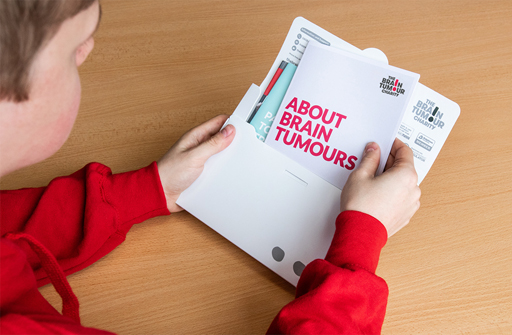Brain scans – CT scan, MRI scan
Brain scans provide a detailed 3D image of the brain by taking multiple pictures of the inside of your head. If you have a brain scan it will likely be a CT scan or an MRI scan, but there are other scans that you might have.

Brain scans are used during diagnosis or for monitoring your tumour. Some people will receive scans as part of active monitoring (also known as watch and wait). They allow doctors to see whether there is a tumour and, if there is, its size and position.
Here we look at the different types of brain scan and explain what you might expect before, during, and after a scan.
On this page:
- What is a brain scan?
- CT scan
- MRI scan
- Before having a scan
- During a scan
- After a scan
- Brain scan FAQs
Get support
If you would like more information or just a listening ear, the members of our kind and approachable Support Team are here for you.
Get your free Information Pack
Our Brain Tumour Information Pack can help you better understand your diagnosis and feel confident talking to your medical team.
Talking to your doctor
Learn more about how to approach your GP.
What is a brain scan?
There are various types of scan that can produce a 3D image of the inside of your head, including your brain.
The two types of brain scan that are most commonly used are:
CT scan
CT stands for Computerised Tomography. You may also sometimes hear doctors referring to CT scans as CAT scans – these are the same thing.
CT scanners use x-rays to take several cross-sectional pictures through your head, then use a computer to stack these 2D picture ‘slices’ into a 3D image.
MRI scan
Magnetic Resonance Imaging, or MRI, uses magnetic fields, rather than x-rays. MRI scanners take pictures from several angles around your head, then build these into a 3D image.
What other types of brain scan might I have?
There are some other types of scan that may be used to diagnose a brain tumour, or to find out more about a diagnosed tumour. These include:
- PET (Positron Emission Tomography) scans
- SPECT (Single Photon Emission Computerised Tomography) scans
- fMRI (functional MRI scan)
- specialised MRI scans.
What to expect from a brain scan
Before your scan
You’ll need to take off anything metal, e.g. glasses, jewellery, hair clips, that may interfere with the scan. Fillings in your teeth and braces are fine, but tell your radiographer about them.
If you’re having an MRI scan, you’ll be asked if you have:
- a pacemaker
- any implants, such as a programmable shunt, infusion pump or skull section
- ever worked in the steel or metal industries, as small metal fragments could be lodged in your body.
If you have, then an MRI may not be suitable for you, as it uses magnetic fields to take images. Your radiographer will be able to tell you more.
For both types of scan, you may be given a fluid called a contrast medium. Usually given via an injection (but sometimes as a drink), it helps to get a clearer image from the scan.
Depending on which contrast medium is used, it may make you feel warm all over, though some people feel cold. Or you may think that you’re passing urine, but you’re not.
Scanxiety
For some people, the thought of having a scan can cause fear and anxiety – either about:
- being in the scanner (I get claustrophobic. What’s it going to be like?)
- waiting for the results (Has the tumour grown or returned?)
These feelings are often called ‘scanxiety’ (scan anxiety).
During the scan
The procedure for both CT scans and MRI scans is very similar.
You’ll lie, usually on your back, on the motorised flatbed that’s part of the scanner. The bed can move in and out of the scanner.
- the CT scanner is shaped like a doughnut or ring, with a round hole in the middle– this is where your head will go
- the MRI scanner is more cylindrical, like a short tube, and your head and shoulders will lie within it.
You’ll probably be given headphones, particularly for an MRI scan. You can usually take music to play through the headphones.
If you tend to get claustrophobic, it’s a good idea to contact the MRI or CT department before the day of your scan to find out the options and support available. You can also have a friend or relative with you if you’re nervous.
Once the staff have got you in the right position, they’ll leave the room, but will be nearby. They can see, hear and talk to you, and you can hear and talk to them. They’ll tell you what will happen.
During the scan, you need to lie very still, so you shouldn’t talk while the actual scan is happening. You may be given a button to hold, which you can press if you need to stop the scan for any reason. But this will mean the scan has to start from the beginning again.
You can breathe normally during the scan.
The scan isn’t painful, nor will the scanner touch you. But, during the scan, you’ll hear noises from the scanner when it’s taking pictures:
- for a CT scan, this will be soft humming and clicks
- for an MRI scan, this will be very loud banging and clanging noises.
After the scan
After the scan, you’ll usually be allowed to go straight home. You should arrange for a friend or relative to accompany you and take you home afterwards.
You should be told when you’ll get your test results.
By joining one of our Online Support Communities, you can get more tips about living with or beyond a brain tumour diagnosis from people who truly understand what you’re going through.
Frequently asked questions
-
Neither scan is better than the other. It’s more a question of which scan is best suited to meet the needs of the person with a brain tumour.
MRI scans and CT scans are similar. Both build up detailed images of the brain. However, there are a few differences:
- MRI scans don’t use ionising radiation to produce the images.
(CT scans use x-rays [ionising radiation], while MRI scans use magnetic fields. - MRI scans usually give more detailed images than CT scans.
- CT scans are quicker and quieter than MRI scans, and people tend to find them less claustrophobic.
- CT scans can be used when there is an implant or piece of metal in the body that means an MRI is not suitable.
- MRI scans don’t use ionising radiation to produce the images.
-
Your whole appointment will take quite a bit longer than the scan itself, as time will be spent getting you into the right position in the scanner.
For MRI scans, time will also be spent explaining the scan and going through the safety questionnaire with you.
For the scan itself:
- CT scan – 5-10 minutes (though the newest CT scanners take about 1 minute to scan the whole brain)
- MRI scan – 15-90 minutes (depending on the size of the area being scanned and how many images are taken).
-
How long this takes will vary.
Scan results should take 1-2 weeks, but it can help to ask how long you should expect to wait. Your doctors may need to first discuss your scan with other members of the medical team at their weekly Multi-Disciplinary Team (MDT) meeting.
-
Though CT scans use ionising radiation, it’s kept at a very low dose and they’re only used when they’re considered necessary, with the benefits outweighing the risks.
MRI scans are completely safe. There are no risks associated with them and they don’t expose your brain to ionising radiation. However, they aren’t suitable for some people who have metal in their body (e.g. some pacemakers).
Very rarely, the contrast medium can affect the kidneys, particularly if your kidneys aren’t working properly. So it’s important to tell you medical team if you have any kidney problems.
Support and Information Services
Research & Clinical Trials Information
You can also join our active online community.
In this section

Get support
If you need someone to talk to or advice on where to get help, our Support and Information team is available by phone, email or live-chat.
Recommended reading
Share your experiences and help create change
By taking part in our Improving Brain Tumour Care surveys and sharing your experiences, you can help us improve treatment and care for everyone affected by a brain tumour.
Coping with scanxiety
Learn more about how to cope when feeling anxious about upcoming scans or while waiting for results.


